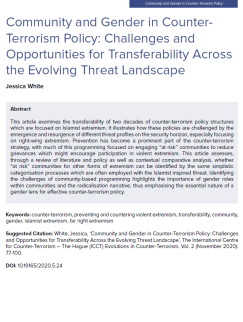The paper illustrates how CT policies are challenged by the emergence and resurgence of different threat profiles, especially on XRIRB. Prevention has become a prominent part of the counter-terrorism strategy, with much of this programming focused on engaging “at risk” communities to reduce grievances which might encourage participation in violent extremism. This article assesses, whether “at risk” communities for other forms of extremism can be identified by the same categorisation processes which are often employed with Islamist extremism. Identifying the challenges of community-based programming highlights the importance of gender roles within communities and the radicalization narrative, thus emphasizing the essential nature of a gender lens for elective counter-terrorism policy.
2020
